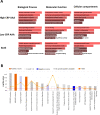CRP immunodeposition and proteomic analysis in abdominal aortic aneurysm
- PMID: 34428207
- PMCID: PMC8384196
- DOI: 10.1371/journal.pone.0245361
CRP immunodeposition and proteomic analysis in abdominal aortic aneurysm
Abstract
Objective: The molecular mechanisms of the degeneration of the aortic wall in abdominal aortic aneurysm (AAA) are poorly understood. The monomeric form of C-reactive protein (mCRP) is deposited in damaged cardiovascular organs and aggravates the prognosis; however, it is unknown whether mCRP is deposited in the degenerated aorta of abdominal aortic aneurysm (AAA). We investigated whether mCRP is deposited in AAA and examined the associated pathogenic signaling pathways.
Methods: Twenty-four cases of AAA were analyzed and their histological features were compared according to the level of serum CRP and the degree of mCRP deposition. Proteomic analysis was performed in AAA cases with strong and diffuse CRP immunopositivity (n = 7) and those with weak, focal, and junctional CRP immunopositivity (n = 3).
Results: mCRP was deposited in the aortic specimens of AAA in a characteristic pattern that coincided with the lesion of the diminished elastic layer of the aortic wall. High serum CRP level was associated with stronger mCRP immunopositivity and a larger maximal diameter of aortic aneurysm. Proteomic analysis in AAA showed that multiple proteins were differentially expressed according to mCRP immunopositivity. Also, ingenuity pathway analysis showed that pathways associated with atherosclerosis, acute phase response, complement system, immune system, and coagulation were enriched in AAA cases with high mCRP immunopositivity.
Conclusions: AAA showed a characteristic deposition of mCRP, and multiple potentially pathologic signaling pathways were upregulated in AAA cases with strong CRP immunopositivity. mCRP and the aforementioned pathological pathways may serve as targets for managing the progression of AAA.
Conflict of interest statement
Eun Na Kim, Jiyoung Yu, Hwangkyo Jeong, Chong Jai Kim, So Ra Kim, Kyunggon Kim, and Se Jin Oh are named as inventors on a pending patent application filed by the University of Ulsan and Seoul National University on the use of proteomic biomarkers for AAA. Other authors report no conflicts of interest. Our information about the patent is shown below. “I have read the journal’s policy and the authors of this manuscript have the following competing interests: The following authors are named as inventors on a patent application (Title: BIOMARKER OF AORTIC ANEURYSM AND USES THEREOF, Application number: 10-2020-0138521, Applicant: ASAN Foundation, Ulsan University, Seoul National University Hospital, Authority: Korea, Republic of) on the use of proteomic biomarkers for abdominal aortic aneurysm: Eun Na Kim, Jiyoung Yu, Hwangkyo Jeong, Chong Jai Kim, Kyunggon Kim, and Se Jin Oh. This does not alter our adherence to PLOS ONE policies on sharing data and materials.
Figures







References
Publication types
MeSH terms
Substances
LinkOut - more resources
Full Text Sources
Research Materials
Miscellaneous

